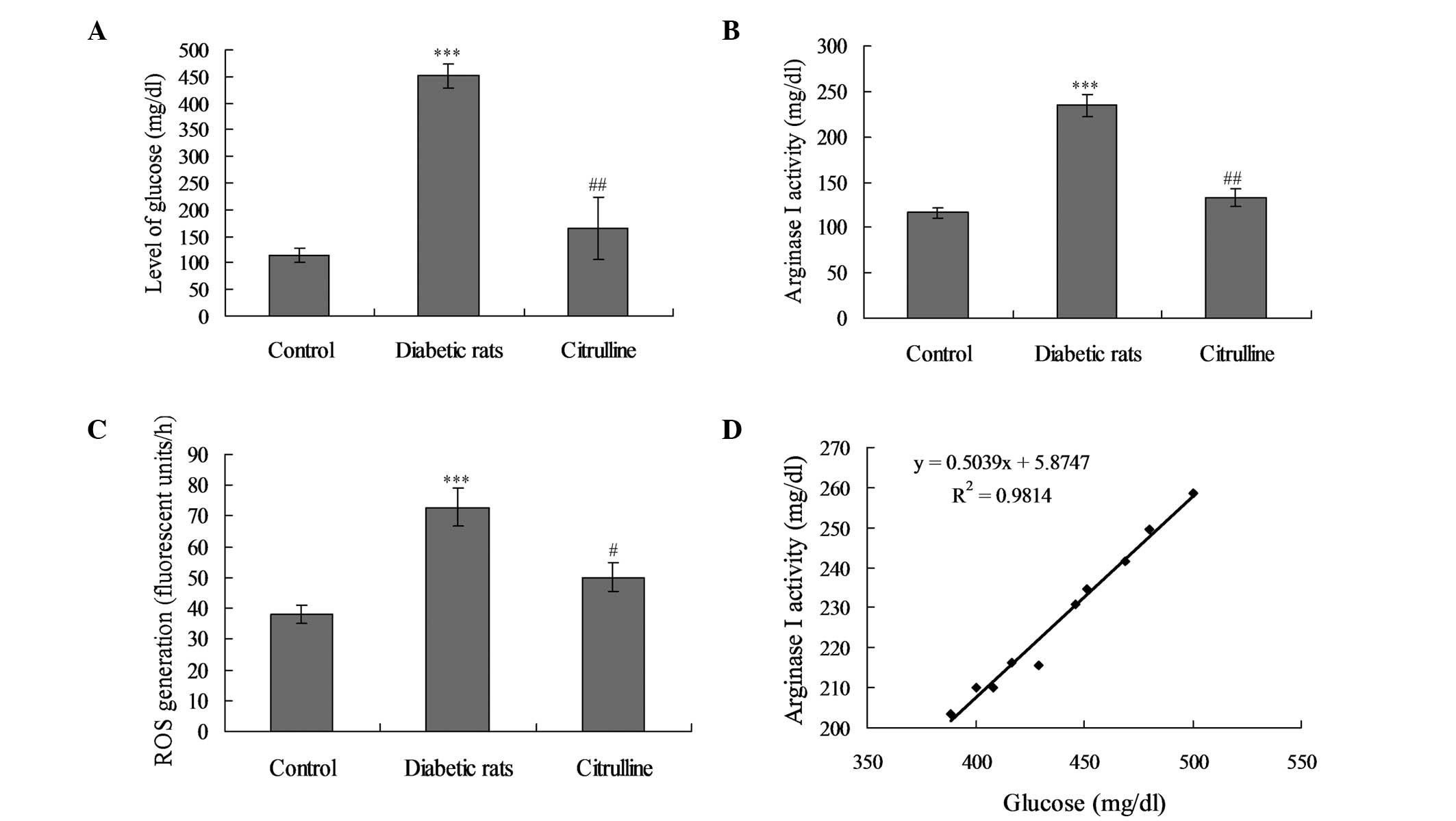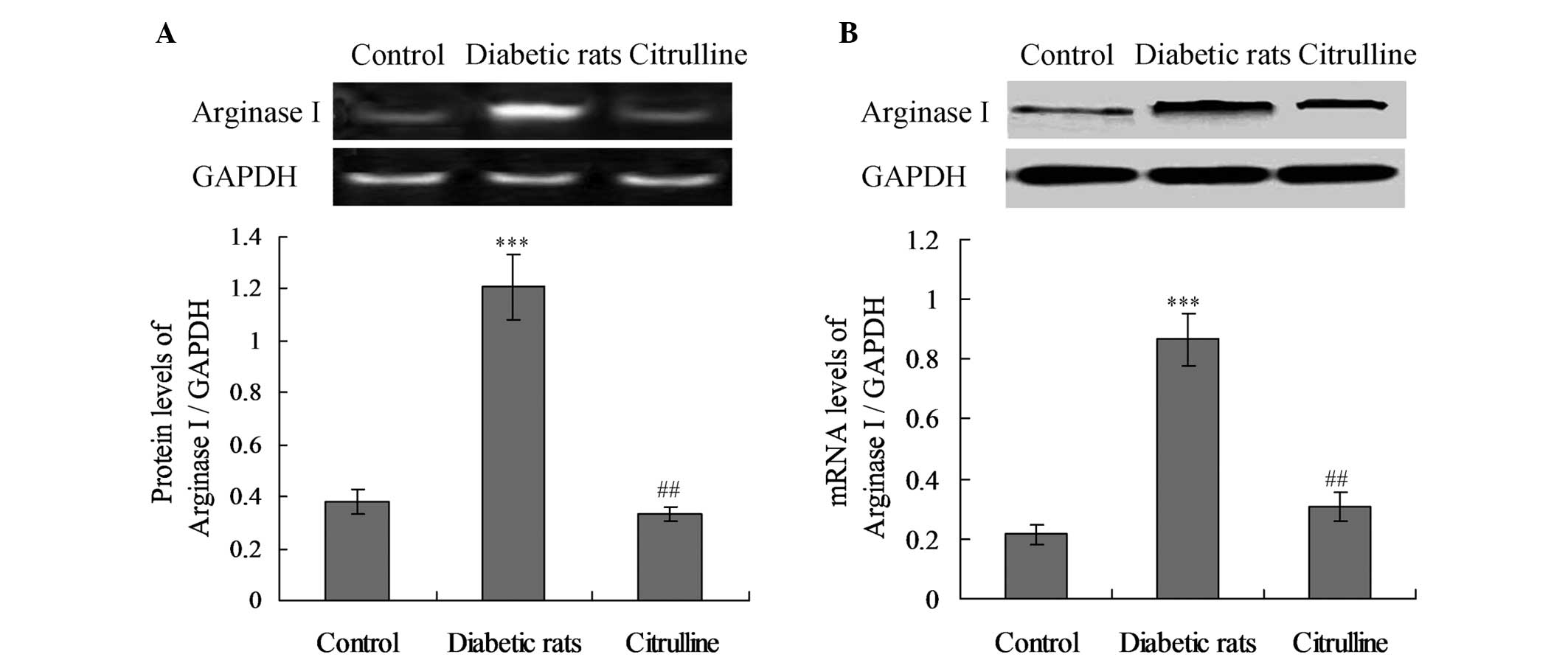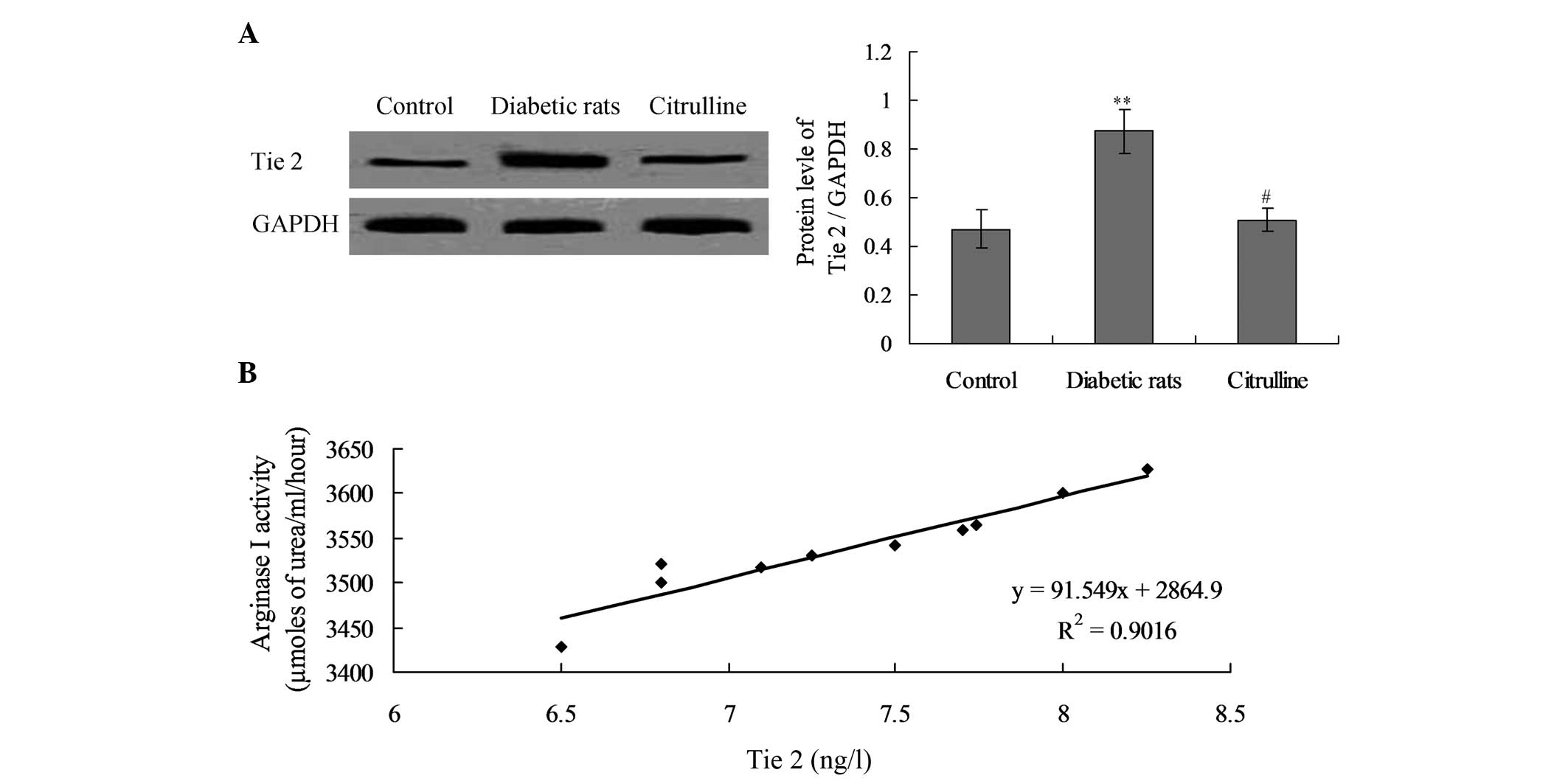|
1
|
Shen K, Ji Y, Chen GQ, Huang B, Zhang X,
Wu S, Yu GP and Wang XC: Expression and clinical significance of
the NDA repair enzyme MYH in esophageal squamous cell carcinoma.
Exp Ther Med. 2:1117–1120. 2011.PubMed/NCBI
|
|
2
|
Cederbaum SD, Yu H, Grody WW, Kern RM, Yoo
P and Iyer RK: Arginases I and II: do their functions overlap? Mol
Genet Metab. 81(Suppl 1): S38–S44. 2004. View Article : Google Scholar : PubMed/NCBI
|
|
3
|
Jenkinson CP, Grody WW and Cederbaum SD:
Comparative properties of arginase. Comp Biochem Physiol B Biochem
Mol Biol. 114:107–132. 1996. View Article : Google Scholar
|
|
4
|
Na S, Kim OS, Ryoo S, Kweon TD, Choi YS,
Shim HS and Oh YJ: Cervical ganglion block attenuates the
progression of pulmonary hypertension via nitric oxide and arginase
pathways. Hypertension. 63:309–315. 2014. View Article : Google Scholar : PubMed/NCBI
|
|
5
|
Yang J, Gonon AT, Sjöquist PO, Lundberg JO
and Pernow J: Arginase regulates red blood cell nitric oxide
synthase and export of cardioprotective nitric oxide bioactivity.
Proc Natl Acad Sci USA. 110:15049–15054. 2013. View Article : Google Scholar : PubMed/NCBI
|
|
6
|
Maarsingh H, Zaagsma J and Meurs H:
Arginase: a key enzyme in the pathophysiology of allergic asthma
opening novel therapeutic perspectives. Br J Pharmacol.
158:652–664. 2009. View Article : Google Scholar : PubMed/NCBI
|
|
7
|
Munder M: Arginase: an emerging key player
in the mammalian immune system. Br J Pharmacol. 158:638–651. 2009.
View Article : Google Scholar : PubMed/NCBI
|
|
8
|
Liu JF, Du ZD, Chen Z, Han ZC and He ZX:
Granulocyte colony-stimulating factor attenuates
monocrotaline-induced pulmonary hypertension by upregulating
endothelial progenitor cells via the nitric oxide system. Exp Ther
Med. 6:1402–1408. 2013.
|
|
9
|
Bekpinar S, Gurdol F, Unlucerci Y, Develi
S and Yilmaz A: Serum levels of arginase I are associated with left
ventricular function after myocardial infarction. Clin Biochem.
44:1090–1093. 2011. View Article : Google Scholar : PubMed/NCBI
|
|
10
|
Zimmet P, Alberti KG and Shaw J: Global
and societal implications of the diabetes epidemic. Nature.
414:782–787. 2001. View
Article : Google Scholar : PubMed/NCBI
|
|
11
|
Hoeldtke RD, Bryner KD, McNeill DR,
Warehime SS, Van Dyke K and Hobbs G: Oxidative stress and insulin
requirements in patients with recent-onset type I diabetes. J Clin
Endocrinol Metab. 88:1624–1628. 2003. View Article : Google Scholar : PubMed/NCBI
|
|
12
|
Taysi S, Polat F, Gul M, Sari RA and Bakan
E: Lipid peroxidation, some extracullar antioxidant enzymes in
serum of patients with rheumatoid arthritis. Rheumatol Int.
21:200–204. 2002. View Article : Google Scholar : PubMed/NCBI
|
|
13
|
Wu G and Meininger CJ: Arginine nutrition
and cardiovascular function. J Nutr. 130:2626–2629. 2000.PubMed/NCBI
|
|
14
|
Fiorentino TV, Prioletta A, Zuo P and
Folli F: Hyperglycemia-induced oxidative stress and its role in
diabetes mellitus related cardiovascular diseases. Curr Pharm Des.
19:5695–5703. 2013. View Article : Google Scholar : PubMed/NCBI
|
|
15
|
Bjelakovic G, Sokolovic D, Ljiljana S,
Kocic G, Jevtovic T, Stojanovic I, IIic M, Bjelakovic LJ, Zivic S,
Pavlovic D, Nikolić J and Basic J: Arginase activity and magnesium
levels in blood of children with diabetes mellitus. J Basic Clin
Physiol Pharmacol. 20:319–334. 2009. View Article : Google Scholar : PubMed/NCBI
|
|
16
|
Teerlink T: Determination of the
endogenous nitric oxide synthase inhibitor asymmetric
dimethylarginine in biological sample by HPLC. Methods Mol Med.
108:263–274. 2005.PubMed/NCBI
|
|
17
|
Newaskar M, Hardy KA and Morris CR: Asthma
in sickle cell disease. Scientific World Journal. 11:1138–1152.
2011. View Article : Google Scholar : PubMed/NCBI
|
|
18
|
Narayanan SP, Rojas M, Suwanpradid J,
Toque HA, Caldwell RW and Caldwell RB: Arginase in retinopathy.
Prog Retin Eye Res. 36:260–280. 2013. View Article : Google Scholar : PubMed/NCBI
|
|
19
|
Pernow J and Jung C: Arginase as a
potential target in the treatment of cardiovascular disease:
reversal of arginine steal? Cardiovasc Res. 98:334–343. 2013.
View Article : Google Scholar : PubMed/NCBI
|
|
20
|
Kang ES, Ford K, Grokulsky G, Wang YB,
Chiang TM and Acchiardo SR: Normal circulating adult human red
blood cells contain inactive NOS proteins. J Lab Clin Med.
135:444–451. 2000. View Article : Google Scholar : PubMed/NCBI
|
|
21
|
Morris CR, Poljakovic M, Lavrisha L,
Machado L, Kuypers FA and Morris SM Jr: Decreased arginine
bioavailability and increased serum arginase activity in asthma. Am
J Respir Crit Care Med. 170:148–153. 2004. View Article : Google Scholar : PubMed/NCBI
|
|
22
|
Giri H, Chandel S, Dwarakanath LS,
Sooriyakala S and Dixit M: Increased endothelial inflammation,
sTie-2 and arginase activity in umbilical cords obtained from
gestational diabetic mothers. PLoS One. 8:e845462013. View Article : Google Scholar : PubMed/NCBI
|
|
23
|
Ramírez-Zamora S, Méndez-Rodríguez ML,
Olguín-Martínez M, Sánchez-Sevilla L, Quintana-Quintana M,
García-García N and Hernández-Muñoz R: Increased erythrocytes
by-products of arginine catabolism are associated with
hyperglycemia and could be involved in the pathogenesis of type 2
diabetes mellitus. PLoS One. 8:e668232013.PubMed/NCBI
|
|
24
|
Wei J, Tang Q, Liu L and Bin J:
Combination of peroxisome proliferator-activated receptor α/γ
agonists may benefit type 2 diabetes patients with coronary disease
through inhibition of inflammatory cytokine secretion. Exp Ther
Med. 5:783–788. 2013.
|
|
25
|
Griesmacher A, Kindhauser M, Andert SE,
Schreiner W, Toma C, Knoebl P, Pietschmann P, Prager R, Schnack C,
Schernthaner G, et al: Enhanced serum levels of
thiobarbituric-acid-reactive substances in diabetes mellitus. Am J
Med. 98:469–475. 1995. View Article : Google Scholar : PubMed/NCBI
|
|
26
|
Xin G, Du J, Wang YT and Liang TT: Effect
of oxidative stress on heme oxygenase-1 expression in patients with
gestational diabetes mellitus. Exp Ther Med. 7:478–482.
2014.PubMed/NCBI
|
|
27
|
Yao L, Chandra S, Toque HA, Bhatta A,
Rojas M, Caldwell RB and Caldwell RW: Prevention of
diabetes-induced arginase activation and vascular dysfunction by
Rho kinase (ROCK) knockout. Cardiovasc Res. 97:509–519. 2013.
View Article : Google Scholar : PubMed/NCBI
|
|
28
|
Elms SC, Toque HA, Rojas M, Xu Z, Caldwell
RW and Caldwell RB: The role of arginase I in diabetes-induced
retinal vascular dysfunction in mouse and rat models of diabetes.
Diabetologia. 56:654–662. 2013. View Article : Google Scholar : PubMed/NCBI
|
|
29
|
Findley CM, Cudmore MJ, Ahmed A and Kontos
CD: VEGF induces Tie 2 shedding via a phosphoinositide 3-kinase/Akt
dependent pathway to modulate Tie 2 signaling. Arterioscler Thromb
Vasc Biol. 27:2619–2626. 2007. View Article : Google Scholar : PubMed/NCBI
|
|
30
|
Onimaru M, Yonemitsu Y, Suzuki H, Fujii T
and Sueishi K: An autocrine linkage between matrix
metalloproteinase-14 and Tie 2 via ectodomain shedding modulates
angiopoietin-1-dependent function in endothelial cells.
Arterioscler Thromb Vasc Biol. 30:818–826. 2010. View Article : Google Scholar
|
|
31
|
Buhimschi CS, Bhandari V, Dulay AT, Thung
S, Rzaeq SS, et al: Amniotic fluid angiopoietin-1, angiopoietin-2,
and soluble receptor tunica interna endothelial cell kinase-2
levels and regulation in normal pregnancy and intraamniotic
inflammation-induced pretern birth. J Clin Endocrinol Metab.
95:3428–3436. 2010. View Article : Google Scholar
|
|
32
|
Sarikaphuti A, Nararatwanchai T,
Hashiguchi T, Ito T, Thaworanunta S, Kikuchi K, Oyama Y, Maruyama I
and Tancharoen S: Preventive effects of Morus alba L.
anthocyanins on diabetes in Zucker diabetic fatty rats. Exp Ther
Med. 6:689–695. 2013.
|

















